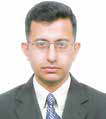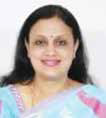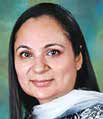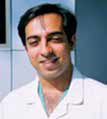Technology has become a part and parcel of the ophthalmic practice. Whether it is in the outpatient department or the operating theatre, technology is everywhere. The pace at which change is happening is often hard to keep up with. AIOS Times interviews top experts and key opinion leaders in the field of ophthalmology to understand their view point regarding the advent of technology, its role today, the way ahead and the potential of losing the human touch. The experts represent the fields of cataract, refractive surgery, glaucoma, cornea, vitreoretina and uvea
Dr Kasu Prasad Reddy (KR), founder and Co-chairman of Maxivision superspecialty eye hospital, Hyderabad is a renowned cataract surgeon who has performed large numbers of laser assisted cataract surgeries and has a handle on the latest technology in his field.
Dr Ronnie George (RG), Deputy Director of glaucoma services at Sankara Nethralaya, Chennai is an avid teacher and researcher and has been at the forefront of change in glaucoma practice over time.
Dr Sujatha Mohan (SM) Associate Medical Director of Rajan Eye Care hospital, Chennai is an anterior segment specialist with a wide experience of corneal and refractive surgeries. She is an eminent surgeon in her field and has received many accolades for the same.
Dr Hemant Murthy (HM), Medical Director and Partner, Retina Institute of Karnataka is a renowned ophthalmologist with a flare for keeping up with the times. A vitreoretinal specialist, he is only too familiar with the rapidly changing scene of ophthalmic medical and surgical practice.
Dr Vishali Gupta (VG) is a Professor of Ophthalmology at PGI Chandigarh. She is a vitreoretina and uvea specialist and is an avid researcher in the fields of intraocular tuberculosis, optical coherence tomography, diabetic retinopathy and fungal endophthalmitis. With a US patent to her name, she is well versed with the need for technological advances.
Dr. Manish Nagpal (MN) is a vitreoretinal specialist at the retina foundation and eye research centre at Ahmedabad. He is an experienced surgeon and has keen interest in live surgery. He often shares his experiences at national and international platforms.
Q1. In what manner has technology changed the way you practice your specialty over the last 10 years?
KR: I started in this specialty in 1983 and for me, ophthalmology since then is fascinating and highly technology driven specialty with lasers, diagnostic imaging and microsurgical techniques. My growth and practice is totally dependent on technology. I am fortunate to get involved in many world renowned prototype technological researches, like Femto Laser Assisted Cataract Surgery (FLACS), for Technolas Bausch and Lomb, Munich, Germany. Today I am recognized for new technologies in the region where I practice advanced technology in Ophthalmology. In these last 10 years selling new technology to those who demanded new technology has been very lucrative and the revenues not only improved my practice but also helped me to further invest into more modern technology.
“A perfect IOL is yet to come…”
– DR. Kasu prasad reddy
RG: The two biggest changes in technology in glaucoma over the past ten years that have been accessible to us in India would be the spectral domain OCT and improved visual field metrics such as the Visual Field Index. Improvements in OCT technology in terms of macular scan, resolution and registration of images have resulted in my using it increasingly to complement visual field findings. Improved visual field metrics have made prediction of progression easier to demonstrate to patients, availability of desktop based visual field software programs that can be easily used to assess large series of visual fields has made judging progression easier. Additionally, integrated OCT and visual field software make the assessment of all relevant patient data simpler. Another change not specific for glaucoma has been the increasing use of electronic medical records which helped in some areas, eg. Quickly assessing factors such as changes in IOP over time.
“The largest changes are coming in the
surgical space with the development of
the minimally invasive glaucoma surgical devices.”
– Dr Ronnie George
SM: The introduction of Femto Laser has revolutionised both refractive & cataract surgeries. Treatment of keratoconus by collagen cross linking which a decade back was not available became a reality & has helped millions around the world. Introduction of phakic IOLS, sutureless vitrectomy and new anti-glaucoma devices have changed the way of managing complex eye diseases
HM: The changes are very significant in both medical retina and surgical retina. OCT now plays an important role in the diagnosis and follow up of various conditions including DME and AMD. Pharmacotherapy has changed the way we treat vascular diseases and AMD. Small gauge surgery has brought greater safety in retinal surgery with superior outcomes.
VG: It has certainly influenced every step of practice including the patient’s registration, ocular examination, ancillary investigations, transmission of the images from machine to several viewing stations, electronic medical records, data storage and retrieval. We cannot imagine any practice without the aid of modern day technology. In fact we are so dependent on technology that the entire system comes to a stand still in case there is a power failure even for a few minutes.
MN: Well, Technology has certainly changed the way we practice vitreoretina. Almost every diagnostic tool in our armamentarium is technologically driven and it keeps updating every few years. New generations of diagnostic equipment as well as those for treatment including lasers, vitrectomy machines, operating microscopes, viewing systems almost everything has undergone a shift.
Q2. For your specialty do you envisage a paradigm shift in the treatment modalities over the next ten years? If so, what are the likely changes?
KR: I definitely foresee a great shift in the treatment modalities in the next 10 year. As a cataract and refractive surgeon I already experienced the changes since 1991 with Excimer Lasers and Lasik and I made lot of changes to my treatment modalities of how I treat my patients, as the trends kept changing from PRK to LASIK to ICL and SMILE. Further with the progress and amalgamation of cataract surgery into refractive laser surgery, I started to combine five different technologies in what I call “PHACOTECHMIX ” or “PHACOMIX”, to deliver the ultimate outcome of Emmetropia. This enables people above the Presbyopic age to get rid of their glasses forever. A perfect IOL is yet to come but I experimented with my own eye with PHACOMIX and the change in the treatment modality for me and is that I “Never do a Refractive Lens Exchange without Femto Laser Emulsification, as I observed that Femtolaser reduces the incidence of Elschnig’s pearls and PCOs”. Apart from cataract and refractive surgery, I foresee plenty of changes in glaucoma. I participated in a study for the French for treating Glaucoma with a device called HIFU (High Intensity Focused Ultrasound) and for the Belgians for new Glaucoma Drainage Device (GDD) prototypes. Further changes in the future will be in the technological advances in IOL technology, for example I recently implanted an IOL called iolAMD, invented by Dr. Bobby Qureshi, from London Hospital and Professor Pablo Artal from Murcia University, for ARMD made by Care group, India. Post-operatively the ARMD patient’s vision improved from CF to 6/24+ and N12, more importantly made the patient very very happy. My prediction to further change in treatment modalities in the next ten years will be in Retina, like using implantable miniature telescope implants for ARMD and Like using Artificial Intelligence in Ophthalmology, Retinal Implants for RP, 3D Printing, Microneedles, Artificial Retina, Vision Implants and changes in drugs in Ophthalmology etc.
RG: There will be many new treatment modalities for glaucoma. The recent approval of two new classes of drugs for glaucoma after 2 decades will offer new medical treatment opportunities. The largest changes are coming in the surgical space with the development of the minimally invasive glaucoma surgical devices. These devices will offer another possibly less invasive surgical option which may be less effective but with potentially fewer complications and at least somewhat simpler to perform than conventional glaucoma surgery. There are also major changes in laser treatment options becoming available both invasive and non-invasive that target the trabecular meshwork or ciliary body. This will lead to graded options for treatment that is currently medical treatment to surgery will probably become – medical – laser – MIGSsurgery
SM: In the field of cornea, Lamellar keratoplasty has become the order of the day. Introduction of Rho kinase inhibitors gives better hope to the challenging situations. Refractive surgery has become more precision driven with newer modalities storming the market.
“ …the problem arises when you replace your clinical skills with technology meaning that the technology becomes your master.”
– Dr Vishali Gupta
HM:The shift will be in the use of artificial intelligence in the diagnosis of retinal conditions. Advances in technology will change the way we do surgery with 3-D surgery with images from OCT and FFA integrated in to the surgical field. Robotic surgery will enter the field. Gene therapy and stem cell treatment will make treatment of congenital retinal conditions possible.
VG: Yes. I do feel that in the next decade, we shall be moving more towards customized and local therapy where we shall be able to check the cytokines that are elevated in the eye of a particular patient and treat that particular cytokine rather than trying to knock down several other cytokines that may be important for the normal functioning. Also the application of nanotechnology in drug delivery and drug depots shall be available in day to day routine practice.
MN: Further enhancements are forthcoming in diagnostics such as OCT Angiography which makes the procedure non-invasive instead of injecting a dye in a patient.. New generation machines are getting better in that area. In vitrectomy the small gauge sutureless surgery has transformed the way we operate. The gauge is further going to get smaller and the cutters and fluidics are undergoing dramatic shifts in the safety and efficiency. Moreover viewing systems are changing and we would start using 3D heads up surgery in the near future. Any imaging and viewing system is going to get further advanced.
Q3. In your opinion, is the current pace of change in technology in ophthalmology a good thing or is it taking away the human touch?
KR: In my opinion, the current pace at which technology in ophthalmology is changing is a very good thing and will not take away the human touch. Femto Laser Assisted Cataract Surgery, FLACS has proved that while technology helped to assist the Surgeon with precision surgery, it did not take away the human touch. I think the man and the machine will go a long way together.
RG: Ophthalmology is fortunate that some of the most recent technological advances in other fields such as adaptive optics and artificial intelligence are being applied in improving patient care in our field. The human touch is still there because all these modalities only add to the value of a good clinical examination and are not a substitute for it.
SM: I do not think personal touch will be replaced by technology. In fact the millennial generation will look for professionals with access to newer technologies. This will increase the bond between doctors & patients.
HM: The changes we have seen in the past 20-30 years have only helped us improving our diagnosis and providing quality care with a same human touch. We have to adapt to the changes.
VG: I think it is a wonderful aid as long as you remain the master and technology is your slave which means that you have the clinical acumen to understand the disease process and use technology to aid your diagnostic and management skills. However, the problem arises when you replace your clinical skills with technology meaning that the technology becomes your master. In such a scenario, the doctor is dependent upon the machine for giving him the answers to the problems and this certainly takes away the clinical skills and human touch.
MN: I think that’s up to us to balance the two aspects. Technology is always useful if we use it in the right way. Personally I think we should have the option of adapting to better technology and if at any point we feel that it is taking away the human touch one could always take an alternative approach.
Q4. What would be the most appropriate manner for ophthalmologists in practice to keep up to date with the advances in technology?
KR: Definitely attending conferences for more information on advanced technologies but ophthalmologists have two tasks on their hands; one of dedicating their time to deliver clinical and surgical outcomes and the second task of keeping up with the trends in Ophthalmology. Once they have chosen an area that interests them they should then offer their time to conduct a study or a clinical trial or even a research in that particular area by initially investing their time and their money. Hard work and dedication to advances in technology is the only way.
RG: Rapid changes in technology can be challenging to keep up with. Fortunately technology does help us here – there are huge resources available online that can help. AIOS has a lot of educational material, IJO publishes on these advances, and access to the O.N.E network for AIOS members opens up many more sources of information. A combination of these resources and attending meetings where experts share their experiences makes it possible to keep up with these advances.
“Rapid changes
in technology can
be challenging to
keep up with.”
– Dr Ronnie George
SM: I think reading journals, attending conferences, taking part in discussions etc. is important to keep up to date. HM: We have an abundance of CME program in all states which provide an avenue for learning about the advances.
VG: Reading the peer reviewed articles, attending conferences and interacting with the experts.
MN: I think various newsletter via speciality based mediums or AIOS from its own sources and of course including it as a part of important symposiums in AIOS and annual speciality meetings would be a good idea.
Q5. Do you see a role for artificial intelligence in ophthalmology in the near future, given that many technology companies are creating algorithms for detection of ocular diseases such as diabetic retinopathy, glaucoma, and macular degeneration etc?
KR: I definitely see, like every ophthalmologist in the Universe a role for the usage of artificial intelligence in ophthalmology. Whilst technology is getting expensive ophthalmologists are assumed to be expensive and screening the population for glaucoma, diabetic retinopathy and ARMD are becoming a Herculean task. Artificial Intelligence is definitely the way forward in this area and more.
RG: Artificial intelligence has already been demonstrated to be effective in detecting some ophthalmic diseases and these algorithms will in my opinion help in improving disease detection. Whether these will be standalone platforms or integrated into devices needs to be seen. Most of the challenges in using these technologies in assessing poor quality images or scans due to media opacities will however persist.
SM: Yes. That is going to be the future. It will make the job of the ophthalmologist much easier to interpret & manage complex eye disease. It will standardise patient care.
HM: AI will be used extensively for screening of diseases. We would benefit with its use as it would help in early detection of diseases like diabetic retinopathy and AMD.
“AI will be used extensively for screening of diseases.”
– Dr Hemant Murthy
VG: Of course. The AI will certainly help in some of the things like screening for diabetic retinopathy, glaucoma, interpreting the OCTs, visual fields etc. and shall be able to help the clinicians in screening the burgeoning population of diabetes in our country.
MN: I am not totally sure how these things would pan out. We keep hearing about AI which would help telemedicine and diagnosing a lot of conditions. We have to see what really comes out of it when these software and programs are developed and in which particular situation they are useful. They may have a role in some areas and countries whilst the same program may not serve much in a different situation. One has to see the overall socio economic issue in relation to benefit that this can give.
Q6. Do you see ophthalmologists playing a back seat role to technology in a decade from now?
KR: No, ophthalmologist’s dream to see precision driven ultimate outcomes for their patients is what is responsible for the growth in technology this far and this attitude will always keep them ahead of technology. We have a hand in glove situation here and one cannot survive without the other. In 2010 I was first invited to Aspen, Colorado to present my work in VICTUS FLACS of Technolas B&L in a prestigious conference of AECOS (American European Congress of Ophthalmic Surgery) and what I noticed there was a combined effort of the world’s greatest investors who invest mountains of money into research for ophthalmic inventions and met some of the greatest Physicists, Scientists and Ophthalmologists. Therefore technology in ophthalmology is a combined effort and a dream of all these great people who strive to invent new techniques to help the man kind, therefore Ophthalmologists will never take a back seat.
RG: From a glaucoma perspective even in the best developed countries glaucoma detection rates in a population are up to 60% (it is 10% for India). If technology helps us to improve these numbers and detect more disease, reaching poorly served areas too, it will make ophthalmologists busier than ever. With an ageing population the number of those affected with glaucoma is only going to increase and I do not believe the ophthalmologist will become irrelevant. If technology can also help identify those at highest risk of progression or vision loss in their lifetimes it will be possible for the specialist to actually spend more time and effort on closely following up those persons at highest risk of vision loss while the less at risk persons could have more lenient follow up schedules.
SM: No. Technology will help doctors to manage patients better . Ultimately the human touch is what cures the patient. HM: Ophthalmologists will continue to provide their services but with greater efficiency and safety with the use of technology.
VG: No. As I mentioned previously, the technology including AI are there to help the clinicians and not replace them. They should be used optimally to get the information that a clinician needs. The final decision, the choice of treatment shall still remain with the physician at least for the next 10 years as patients do not like to be treated by machines. The human touch and decision making capacity shall stay with the physicians.
MN: I don’t think so. Technology by itself is not something that I would trust on its own. We need to be in control at all given points or else we would find ourselves over treating or under treating patients just because the machines tell us to. We have to always customise a treatment protocol for every individual patient and I think no matter how good the technology it’s us ophthalmologists who can use it to the fullest by taking a front seat. We have to use it to our advantage but not let it control our judgement.
“Technology by itself
is not something that
I would trust on its own.”
– Dr. Manish Nagpal
Q7. Given that computerisation and technology is fast replacing manual techniques do you see a need for updating ophthalmology training and residency programs?
KR: My personal opinion is that updating ophthalmology training and residency programs is very very important. Presently in our residency programme we are all taught the theoretical and practical aspects of clinical and surgical ophthalmology and nothing about computers, Technology, Practice Management and handling patients. For example, manual RK cuts were replaced by Excimer Laser ablations to blast Bowmen layer to flatten the central cornea. Books have to be rewritten to say that destroying Bowmen layer will not cause scarring. Residents in USA don’t know what SICS is all about and there in future with FLACS, Zepto, residents will soon forget manual capsulotomy and this could happen in our own country; therefore updating ophthalmology training and residency programs on an yearly basis by the concerned Pundits is very important.
“…updating
ophthalmology training
and residency programs
is very very important.”
– Dr Kasu Prasad Reddy
RG: Newer technology should be incorporated into residency and training programs but we have to first ensure that all existing training programs at least have the basic requirements for a good comprehensive eye examination and that all trainees are trained in their use. This is unfortunately not the case today where there are large differences in training environments with some providing access and training with state of the art equipment and others lacking even the basic equipment. The same dichotomies will apply to patient care. Improvements in technology will have varied penetrance into different parts of the country and it is necessary to ensure our residents and trainees are trained to be good comprehensive ophthalmologists first.
SM: Yes. There is a vast difference in the teaching pattern at medical college oriented practice versus the private hospitals with DNB . The later focuses only on the speciality of choice & hence the final outcome of students is far better than in medical college degrees such as MS.
HM: Our residency/ post graduate programs are outdated in most places hence we see all post graduates rushing for fellowship programs to upgrade their skills.
VG: That is the need of the hour. The curriculum is too outdated and needs to be the updated with the changing times so that we are not producing an outdated generation of ophthalmologists.
MN: Absolutely. residents and fellows have to be exposed to all the new technology which is there as well as what is in the pipeline.





